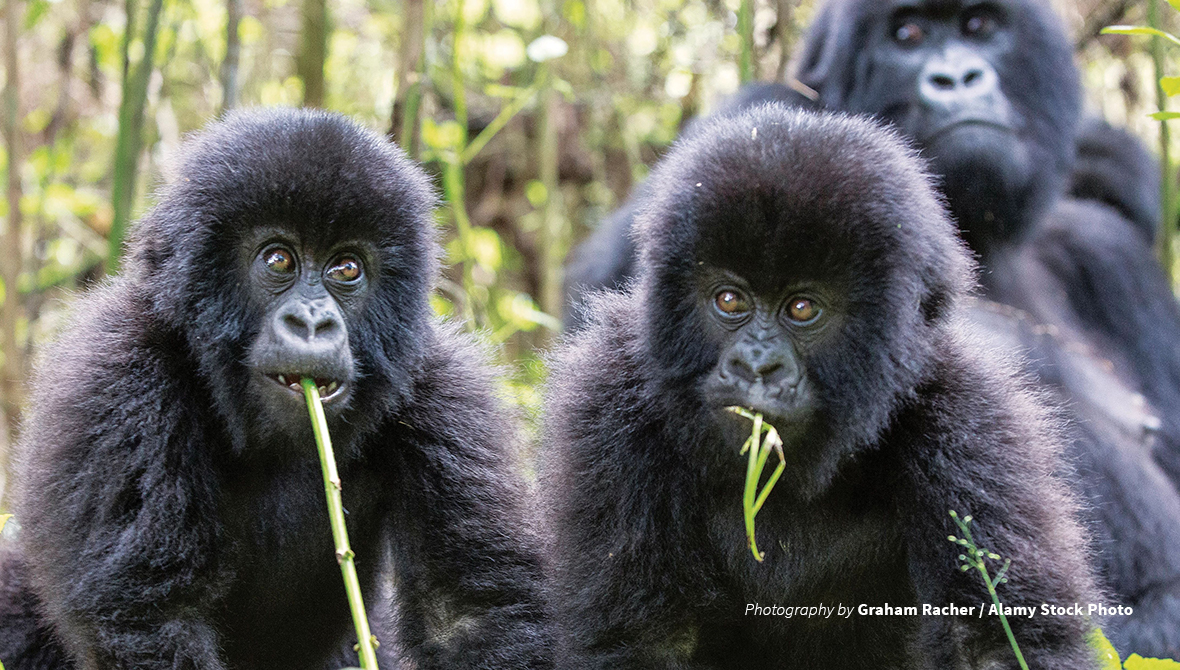Protecting Rwanda’s mountain gorillas

As African Wildlife Foundation celebrates our 60th anniversary, we are sharing stories that honor our past, celebrate the present, and look forward to the future
The rebound of the world's precious mountain gorilla population from only a few hundred at the lowest point to over 1,000 today is one of conservation's most celebrated victories and a testament to the value of decades of investment in conservation leadership. Although the iconic great apes’ conservation status remains fragile, AWF’s role in this success story — intricately linked to our leadership mission — represents one of our proudest chapters.
The chapter begins with Dian Fossey. “One of the basic steps in saving a threatened species,” she wrote as a young researcher, “is to learn more about it — its diet, its mating and reproductive processes, its range patterns, its social behavior.” AWF was of the same mind, and in the late 1960s, we expanded our programmatic focus to begin supporting long-term ecological and behavioral studies like Fossey’s (mountain gorillas) and Cynthia Moss’s (elephants). Both Fossey and Moss would become pivotal conservation figures, not only as scientists who increased the world’s knowledge of (and enthusiasm about) mountain gorillas and elephants, but also as individuals driven by the realities of poaching to become conservationists on the global stage.
Fossey was a proud and passionate protector of the apes she came to regard as family and shared glimpses of their personalities and daily lives through National Geographic Magazine and other media. When poachers killed the beloved silverback Digit and then two other males, there was an international outcry. In response, Rwandan President Habyarimana challenged the leading conservation NGOs working in Africa to come up with methods and funding to protect the gorillas.
Ultimately, AWF, the Fauna Preservation Society, and the World Wildlife Fund formed a consortium to bring various funds and initiatives under one tent and help fulfill the Rwandan request. The Mountain Gorilla Project, with AWF at the helm, focused on capacity-building, anti-poaching, and awareness-building. The project also worked to habituate mountain gorillas to tourist groups, training Rwandan rangers in new methods.
Fossey’s tragic murder in 1986 did not stop the concerted gorilla protection efforts. Anti-poaching forces continued to patrol the park every day, collecting and destroying the deadly snares that threatened gorillas. This constant vigilance proved worthwhile. A 1989 census showed the gorilla population to be increasing. Moreover, the Mountain Gorilla Project tourism program was infusing badly needed tourist dollars into the Rwandan economy. By the end of the decade, tourism income was Rwanda's largest earner of foreign exchange, making gorilla protection a national priority.
During this time, a young conservationist and former Peace Corps volunteer, Craig Sholley (today AWF senior vice president) joined the project. In collaboration with the park's chief warden, Sholley coordinated park protection and anti-poaching activities, supervised conservation education, and monitored the gorillas’ well-being. He also traveled to Kigali frequently to meet with government leaders and maintain a productive working relationship.
In 1990, the Mountain Gorilla Project would move where it belonged — under the stewardship of the Rwandan government, fulfilling AWF’s vision of investing leadership and ownership of conservation programs with African governments and people. Gorilla protection and tourism would now be integral to Rwanda’s daily park management and the country's economic plans.
Says Sholley today: “The course of our early mountain gorilla conservation efforts, from the first days, through the transfer of the Mountain Gorilla Project to the Rwandan government, through today, a time in which the Rwandan government is arguably leading the way in African wildlife conservation — all of this I believe proves the wisdom of AWF’s founding vision, that conservation, to be successful, must be led by and owned by Africa's people and governments.”
AWF continues to provide technical guidance, create educational materials, and support anti-poaching patrols. We also helped form a new initiative, the International Gorilla Conservation Program, a regional collaborative focused on protecting gorillas and their habitat in all range countries — Rwanda, Uganda, and Zaire (now the Democratic Republic of the Congo.
The gorilla program and gorilla conservation generally were greatly challenged in the 1990s, during Rwanda’s civil war and genocide. But quite remarkably, few gorillas were killed during the region’s worst violence and the displacement of thousands of Rwandans. As Rwanda rebuilt from this terrible time, gorilla protection would see great developments.
In all three range nations the program enhanced the conservation of mountain gorillas living in the Virunga mountains and Uganda’s Bwindi Impenetrable National Park. The project became a model for international cooperation, as wardens and rangers from countries in conflict worked together so closely that they became friends as well as respected colleagues.
The International Gorilla Conservation Program facilitated this regional cooperation, including joint border patrols by Rwandan, Congolese, and Ugandan rangers. It also put in place coordinated ecological monitoring, tourism development, and community engagement activities.
> Learn more about how tourism supports mountain gorillas living in Volcanoes National Park
